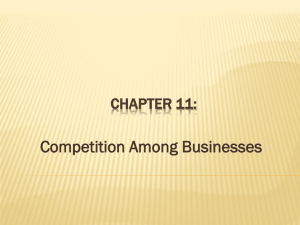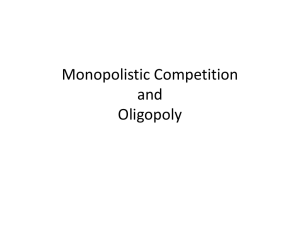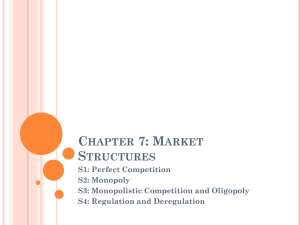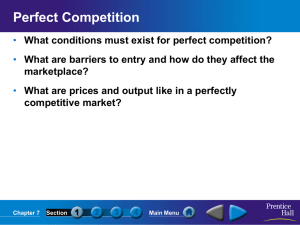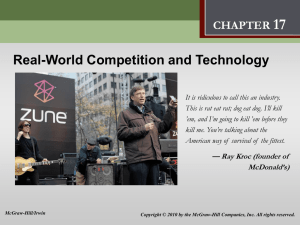Competition
advertisement
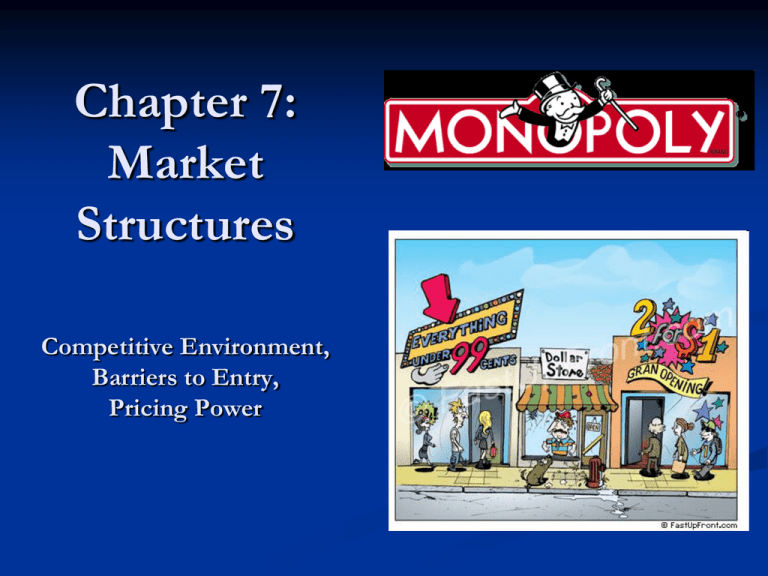
Chapter 7: Market Structures Competitive Environment, Barriers to Entry, Pricing Power Background Discussion Here are 4 products in the marketplace: Corn Restaurant meals Mobile phone service Electricity How would an entrepreneur compete? Perfect Competition The simplest market structure is known as perfect competition. A perfectly competitive market is one with a large number of firms all producing essentially the same product Each firm produces so little of the product compared to total supply, no single producer can influence price; they are known as “price takers.” Conditions for Perfect Competition There are surprisingly only a few good examples of perfect competition because of the conditions needed for a perfectly competitive market. 1. Many Buyers and Sellers - There are many participants on both the buying and selling sides. 2. Identical Products - There are no differences between the products sold by different suppliers. Typically, commodities! 3. Informed Buyers and Sellers - The market provides the buyer with full information about the product and its price. 4. Free Market Entry and Exit - Firms can enter the market when they can make money and leave it when they can't. Low barrier to entry! Examples of Perfect Competition It is difficult to meet all 4 criteria for perfect competition. Examples tend to be commodities – a product that is the same no matter who produces it Roofing nails, paper clips Ag products: milk, corn Notebook or copy paper Why isn’t there more perfect competition? barriers to entry are the most common reason we don’t see more examples of perfect competition A barrier to entry is any factor that creates an obstacle for a new firm to enter a market Barriers to entry result in imperfect competition Examples of Barriers Start-up Costs The expenses that a new business must pay before the first product reaches the customer are called start-up costs. Have to buy land, labor, capital Technology Some markets require a high degree of technological know-how. As a result, new entrepreneurs cannot easily enter these markets. Human and physical capital Monopoly Applied The concept of a monopoly helps explain why some prescription drug prices are so high, why the DMV is so bad with customer service, and why there is only one passenger railroad company left in the US. Monopoly Defined A monopoly is a market dominated by a single seller. Monopolies form when impenetrable barriers prevent firms from entering a market that has a single supplier. Monopolies can take advantage of their monopoly power and charge high prices; they are known as “price makers.” Causes of a Monopoly 1. Economies of Scale 2. Natural Monopolies If a firm's start-up costs are high, and its average costs fall for each additional unit it produces, then it enjoys what economists call economies of scale. An industry that enjoys economies of scale can easily become a natural monopoly. Examples include cable TV, utilities A natural monopoly is a market that runs most efficiently when one large firm provides all of the output. 3. Technology and Change Sometimes the development of a new technology can destroy a natural monopoly. Natural Monopolies When a market runs most efficiently with only one large firm providing the output, it is known as a “natural monopoly” Public water is a good example If different companies had to set up separate reservoirs, separate pipes, and separate cleaning/distribution systems Often in the case of a natural monopoly the government provides the service (which comes with some inefficiency) MCWA, sewers, airports (ROC) Or govt. will regulate certain industries: RG&E, TWC. Technology and Change Technology can disrupt a monopoly and move the market back into competition Prior to the 1990s land-line phones were close to a monopoly Cell-phones disrupted the monopoly and now compete with land-line phone companies Other Government Created Monopolies A government monopoly is a monopoly created by the government. Technological Monopolies Franchises and Licenses Industrial Organizations Government Monopoly Technological Monopolies The government grants patents, licenses that give the inventor of a new product the exclusive right to sell it for a certain period of time. Pharmaceuticals Patents for most goods Why? Government Monopoly (cont’d) Franchises and Licenses - A franchise is a contract that gives a single firm the right to sell its goods within an exclusive market. A license is a government-issued right to operate a business. Food vendors at National Parks School soda machines (in some schools) Radio and TV stations Why? Government Monopoly (cont’d) Technological Monopolies/ Industrial Organizations In rare cases, such as sports leagues, the government allows companies in an industry to restrict the number of firms in the market. Most sports leagues Why? Pros/Cons? Monopolistic competition In monopolistic competition, many companies compete in an open market to sell products which are similar, but not identical. Each firm technically holds a monopoly over its specific product/brand Goods sold under monopolistic competition are similar enough that they can be substituted, but they are not identical 4 Conditions of Monopolistic Competition 1. Many Firms 2. Few Artificial Barriers to Entry Firms in a monopolistically competitive market do not face high barriers to entry. 3. Slight Control over Price As a rule, monopolistically competitive markets are not marked by economies of scale or high start-up costs, allowing more firms. Firms in a monopolistically competitive market have some freedom to raise prices because each firm's goods are a little different from everyone else's. 4. Differentiated Products Firms have some control over their selling price because they can differentiate, or distinguish, their goods from other products in the market. Examples Possible examples of monopolistic competition shampoo Toilet Paper Jeans Pizza Other ways to compete Nonprice competition is a way to attract customers through style, service, or location, but not a lower price. 1. Characteristics of Goods The simplest way for a firm to distinguish its products is to offer a new size, color, shape, texture, or taste. 2. Location of Sale A convenience store in the middle of the desert differentiates its product simply by selling it hundreds of miles away from the nearest competitor. Nonprice Competition (cont’d) 3. Service Level Some sellers can charge higher prices because they offer customers a higher level of service. 4. Advertising Image Firms also use advertising to create apparent differences between their own offerings and other products in the marketplace. Prices, Profits, Output Prices Profits Prices will be higher than they would be in perfect competition, because firms have a small amount of power to raise prices. While monopolistically competitive firms can earn profits in the short run, they have to work hard to keep their product distinct enough to stay ahead of their rivals. Costs and Variety Monopolistically competitive firms cannot produce at the lowest average price due to the number of firms in the market. They do, however, offer a wide array of goods and services to consumers. Oligopolistic Competition Oligopoly describes a market dominated by a few large, profitable firms. Examples Soft Drinks Cars Music Cereal What to watch out for—illegal practices: Collusion Price- fixing an agreement among members of an oligopoly to set prices and production levels. an agreement among firms to sell at the same or similar prices. Cartel an association by producers established to coordinate prices and production. (OPEC is a legal cartel.) Review: Know this chart! Perfect Comp. Monopolistic Oligopoly Comp. Monopoly # of Firms Many, Many Many A few dominate One Variety of goods None Some Some None Control over prices None Little Some Complete Barriers to entry Few Low High Complete Examples Wheat, Corn, Paper Jeans, Pizza Cars, Movies Public water Review 1. The differences between perfect competition and monopolistic competition arise because (a) in perfect competition the prices are set by the government. (b) in perfect competition the buyer is free to buy from any seller he or she chooses. (c) in monopolistic competition there are fewer sellers and more buyers. (d) in monopolistic competition competitive firms sell goods that are similar enough to be substituted for one another. 2. An oligopoly is (a) an agreement among firms to charge one price for the same good. (b) a formal organization of producers that agree to coordinate price and output. (c) a way to attract customers without lowering price. (d) a market structure in which a few large firms dominate a market. Regulation The US goes through waves of regulation and deregulation Like a pendulum swinging back and forth We are now seeing a push for more government regulation Why regulate at all? Markets dominated by a few large firms tend to have higher prices and lower output than markets with many sellers. To control prices and output like a monopoly, firms sometimes use predatory pricing. Predatory pricing sets the market price below cost levels for the short term to drive out competitors. Such as China dumping TVs on the US market Why regulate? (cont’d) Government policies keep firms from controlling the prices and supply of important goods. Antitrust laws are laws that encourage competition in the marketplace. (Sherman!) Why regulate? (cont’d) 1. Regulating Business Practices 2. Breaking Up Monopolies The government has used anti-trust legislation to break up existing monopolies, such as the Standard Oil Trust and AT&T. 3. Blocking Mergers The government has the power to regulate business practices if these practices give too much power to a company that already has few competitors. A merger is a combination of two or more companies into a single firm. The government can block mergers that would decrease competition. 4. Preserving Incentives In 1997, new guidelines were introduced for proposed mergers, giving companies an opportunity to show that their merging benefits consumers. Why deregulate? Deregulation is the removal of some government controls over a market. Try to get back to free market forces Deregulation is used to promote competition. Many new competitors enter a market that has been deregulated. This is followed by an economically healthy weeding out of some firms from that market, which can be hard on workers in the short term. Review 1. Antitrust laws allow the U.S. government to do all of the following EXCEPT (a) regulate business practices (b) stop firms from forming monopolies (c) prevent firms from selling new experimental products (d) break up existing monopolies 2. The purpose of both deregulation and antitrust laws is to (a) promote competition (b) promote government control (c) promote inefficient commerce (d) prevent monopolies


